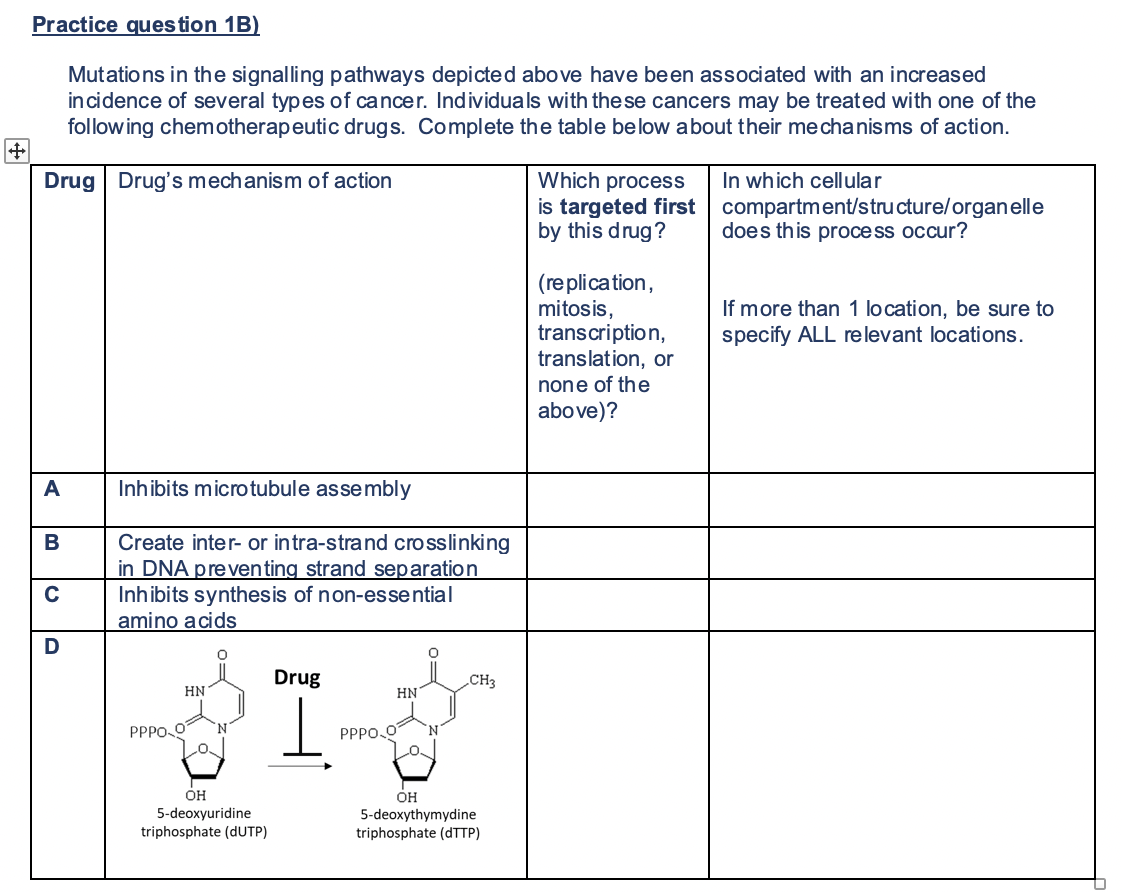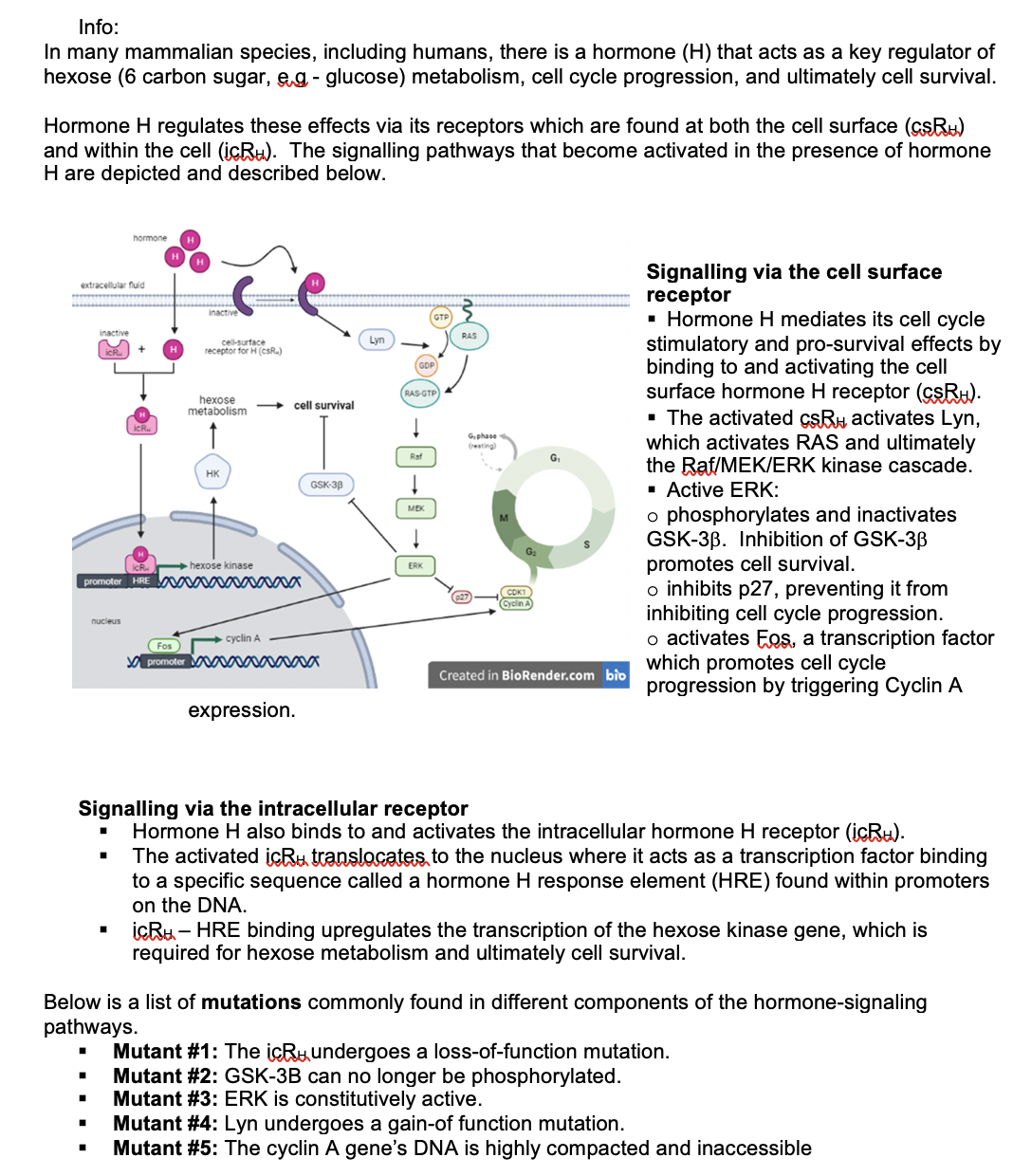Practice ques tion 1B) Mutations in the signalling pathways depicte d above have been associated with an increased incidence of several types of cancer. Individuals with the se cancers may be treated with one of the following chemotherapeutic drugs. Complete the table below about their mechanisms of action. In which cellular Which process is targeted first compartment/stru cture/organelle by this drug? Drug | Drug's mechanism of action does this proce ss occur? (replication, mitosis, transcription, translation, or If more than 1 location, be sure to specify ALL relevant locations. none of the above)? A Inhibits microtubule assembly Create inter- or intra-strand crosslinking in DNA preventing strand separation Inhibits synthesis of non-essential amino acids B Drug „CH3 HN HN PPPO O PPPO O он OH 5-deoxyuridine 5-deoxythymydine triphosphate (DUTP) triphosphate (dTTP)
Practice ques tion 1B) Mutations in the signalling pathways depicte d above have been associated with an increased incidence of several types of cancer. Individuals with the se cancers may be treated with one of the following chemotherapeutic drugs. Complete the table below about their mechanisms of action. In which cellular Which process is targeted first compartment/stru cture/organelle by this drug? Drug | Drug's mechanism of action does this proce ss occur? (replication, mitosis, transcription, translation, or If more than 1 location, be sure to specify ALL relevant locations. none of the above)? A Inhibits microtubule assembly Create inter- or intra-strand crosslinking in DNA preventing strand separation Inhibits synthesis of non-essential amino acids B Drug „CH3 HN HN PPPO O PPPO O он OH 5-deoxyuridine 5-deoxythymydine triphosphate (DUTP) triphosphate (dTTP)
Biochemistry
6th Edition
ISBN:9781305577206
Author:Reginald H. Garrett, Charles M. Grisham
Publisher:Reginald H. Garrett, Charles M. Grisham
Chapter32: The Reception And Transmission Of Extracellular Information
Section: Chapter Questions
Problem 5P
Related questions
Question

Transcribed Image Text:Practice question 1B)
Mutations in the signalling pathways depicted above have been associated with an increased
incidence of several types of cancer. Individuals with the se cancers may be treated with one of the
following chemotherapeutic drugs. Complete the table below about their me chanisms of action.
In which cellular
Which process
is targeted first compartment/structure/organelle
by this drug?
Drug
Drug's mechanism of action
does this proce ss occur?
(replica tion,
mitosis,
transcription,
translation, or
If more than 1 location, be sure to
specify ALL relevant locations.
none of the
above)?
A
Inhibits microtubule assembly
Create inter- or intra-strand crosslinking
in DNA preventing strand separation
Inhibits synthesis of non-essential
amino acids
Drug
CH3
HN
HN
PPPO O
N.
PPPO O
OH
OH
5-deoxythymydine
triphosphate (DTTP)
5-deoxyuridine
triphosphate (DUTP)

Transcribed Image Text:Info:
In many mammalian species, including humans, there is a hormone (H) that acts as a key regulator of
hexose (6 carbon sugar, eg - glucose) metabolism, cell cycle progression, and ultimately cell survival.
Hormone H regulates these effects via its receptors which are found at both the cell surface (csRu)
and within the cell (icRu). The signalling pathways that become activated in the presence of hormone
H are depicted and described below.
hormone
Signalling via the cell surface
receptor
· Hormone H mediates its cell cycle
stimulatory and pro-survival effects by
binding to and activating the cell
surface hormone H receptor (csRu).
· The activated csRu activates Lyn,
which activates RAS and ultimately
the Raf/MEK/ERK kinase cascade.
· Active ERK:
o phosphorylates and inactivates
GSK-3B. Inhibition of GSK-3ß
promotes cell survival.
o inhibits p27, preventing it from
inhibiting cell cycle progression.
o activates Eos, a transcription factor
which promotes cell cycle
progression by triggering Cyclin A
extracellular fluid
inactive
GTP
inactive
RAS
Lyn
cell-surface
receptor for H (csR.)
icR.
RAS-GTP
hexose
metabolism
cell survival
icR.
Gphase
(resting)
Raf
HK
GSK-38
MEK
hexose kinase
ERK
promoter HRE A
COKI
nucleus
+ cyclin A
Fos
A promoter a
Created in BioRender.com bio
expression.
Signalling via the intracellular receptor
Hormone H also binds to and activates the intracellular hormone H receptor (icRu).
The activated icRu translocates, to the nucleus where it acts as a transcription factor binding
to a specific sequence called a hormone H response element (HRE) found within promoters
on the DNA.
icRu- HRE binding upregulates the transcription of the hexose kinase gene, which is
required for hexose metabolism and ultimately cell survival.
Below is a list of mutations commonly found in different components of the hormone-signaling
pathways.
Mutant #1: The içRuundergoes a loss-of-function mutation.
Mutant #2: GSK-3B can no longer be phosphorylated.
Mutant #3: ERK is constitutively active.
Mutant #4: Lyn undergoes a gain-of function mutation.
Mutant #5: The cyclin A gene's DNA is highly compacted and inaccessible
Expert Solution
This question has been solved!
Explore an expertly crafted, step-by-step solution for a thorough understanding of key concepts.
Step by step
Solved in 2 steps

Knowledge Booster
Learn more about
Need a deep-dive on the concept behind this application? Look no further. Learn more about this topic, biology and related others by exploring similar questions and additional content below.Recommended textbooks for you

Biochemistry
Biochemistry
ISBN:
9781305577206
Author:
Reginald H. Garrett, Charles M. Grisham
Publisher:
Cengage Learning

Anatomy & Physiology
Biology
ISBN:
9781938168130
Author:
Kelly A. Young, James A. Wise, Peter DeSaix, Dean H. Kruse, Brandon Poe, Eddie Johnson, Jody E. Johnson, Oksana Korol, J. Gordon Betts, Mark Womble
Publisher:
OpenStax College

Biology 2e
Biology
ISBN:
9781947172517
Author:
Matthew Douglas, Jung Choi, Mary Ann Clark
Publisher:
OpenStax

Biochemistry
Biochemistry
ISBN:
9781305577206
Author:
Reginald H. Garrett, Charles M. Grisham
Publisher:
Cengage Learning

Anatomy & Physiology
Biology
ISBN:
9781938168130
Author:
Kelly A. Young, James A. Wise, Peter DeSaix, Dean H. Kruse, Brandon Poe, Eddie Johnson, Jody E. Johnson, Oksana Korol, J. Gordon Betts, Mark Womble
Publisher:
OpenStax College

Biology 2e
Biology
ISBN:
9781947172517
Author:
Matthew Douglas, Jung Choi, Mary Ann Clark
Publisher:
OpenStax